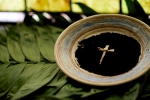June 30, 2021
Sacramental Theology in the Time of COVID

The global COVID-19 pandemic has forced us to examine and adapt our lifestyles across the board- working from home (#WFH) became the new normal, even growing increasingly through new software platforms and new approaches to conducting business. The Church has not been insulated from this, and our reactions have brought forth a great many questions and concerns about the functionality of our place as ministers and shepherds in a landscape so drastically changed. Nearly every single priest friend I have has commented on their personal struggles with how to be a parish priest without a parish present in the pews; how to find meaning in their role as a priest, both in interacting with their parishioners, and in their own personal spiritual nourishment.
Debriefing our Pandemic Protocols and Looking Forward
In reflecting on the changes we’ve experienced over the last 12 months, it strikes me that the practices we have embraced to “survive” the pandemic have been temporary, or perhaps, a means to an end, without much long term consideration for how this will have changed our worship practice beyond the pandemic. As a sacramental theologian, my concern immediately leaps to how we can continue to experience the sacraments in the uncharted waters in which we found ourselves, and from which we continue to emerge. How can we find meaning in these things that root us in our theology, Christology, and our ecclesiology without being able to experience them in person, or in the setting in which we are accustomed?
Even now, as we see the proverbial light at the end of the tunnel, it seems impossible to return to “business as usual,” and leave our emergency provisions behind. As we emerge from our bunkers and our eyes adjust to the sunlight of our post pandemic world, I think we are being given an opportunity to find renewed meaning in our ecclesiastical practices, embrace the challenges we have been given as church leaders, face the future of our church in the aftermath of COVID, and in our ever-evolving modern technological world.
Have our Pandemic Protocols modified our Sacramental Theology?
The Holy Eucharist is the most obvious sacrament which bears examination in light of the restrictions placed due to the necessity of quarantine, masks, and social distancing. Given that the Eucharist is the “principal act of Christian worship”, it has been given the most attention by clergy and theologians thus far. And, indeed, it requires additional thought. A great many of the parishes, dioceses, and priests I am acquainted with either ceased to provide the eucharistic elements to their parishioners, reduced the sacrament to being received in one kind only, or adopted a Morning Prayer-style worship service for Sunday mornings. I am aware of one parish that has taken on an “ocular communion,” based largely on the office of benediction and the exposition of the Holy Sacrament in the monstrance. [This particular choice merits its own theological discussion; those being “pro” ocular communion rooted in the likes of Hugh of Saint Victor and the Letter to the Romans, while those against suggest that the First Letter to the Corinthians conclusively excludes it from being a “viable” replacement. These examples are decidedly generalized and over-simplified, and I will spend the bulk of the next article digging into the arguments surrounding Eucharistic participation and virtual worship.] Regardless of choices around Eucharistic practice, most parishes moved either to a strictly virtual worship via livestreaming or Zoom, while others with limited re-opening capacity, maintained their virtual presence alongside in-person worship, for those who cannot be there physically.
All of this begs the question, is there such a thing as virtual sacramental theology and virtual sacramental efficacy? Even as I type this question, I can almost hear Peter Lombard rolling in his grave. But, while pandemic would not be an unfamiliar concept to Peter Lombard, I’m certain he never imagined a world in which it would be possible for the faithful to attend mass, without setting foot in a church. So it falls to us to determine what ways, if any, the sacraments can be communicated and efficacious under the unprecedented circumstances in which we find ourselves.
My theological “style,” for want of a better word, is one in which I examine the past to illuminate the present; that is to say, I look to historic biblical and theological texts and writings to determine a contemporary application. I do not mean to imply that I try to seat historic positions into a contemporary circumstance and expect them to fit, but, rather, that I use these texts to extrapolate from the fundamental principles within an appropriate relevance and use for our modern world. I further do not intend to suggest that ancient writers and scholars got it right all the time, but that there is always something to be learned, even from erroneous suppositions and assertions.
Using What We’ve Learned as a Lens for our Future
Having said that, I think it is of the utmost importance that we examine possible ways for technology to enhance our worship, without it removing the sanctity and reverence of our liturgies. I do not suggest we become a church of big screens, or that virtual worship can completely replace in-person worship, nor should it. I do, however, believe that in order to continue to serve our members, particularly in light of this unprecedented time of isolation, grief, and uncertainty, we must put our technological advancements to use to enrich the Church, give comfort to the grieving and lonely, maintain the feeling of community and belonging, and reinforce our relevance as the Church of God.
Prior to the pandemic, we have seen attendance numbers drop, and a dwindling population of younger members. Perhaps, this is also a way to remedy these existing struggles, and to continue to explore ways in which we can grow the church and reassert our relevance in contemporary times. Indeed, for some parishes, a silver lining of our necessitated worship adaptation has been an increase in numbers of attendees, and a broadening of our communion beyond geographical borders. With all of these issues in mind, we need to examine those core acts of worship and pillars of our faith so that we neither make heretics of ourselves, nor neglect the basic theological principles outlining our liturgies through oversimplification. Thus, we must turn to the sacraments of the church as a starting point.
This presupposes that we generally acknowledge that a sacrament is, in its most basic definition, “an outward and visible sign of inward and spiritual grace,” in which case we can agree that there are seven. I recognize that, according to the Articles of Religion, only two sacraments are ordained by Christ, namely Baptism and the Holy Eucharist, however, we would be remiss to not give attention to the remaining five, particularly in light of the uncertainty of the duration of current pandemic protocols and the certainty that this pandemic will not be our last. Some sacraments are decidedly more “hands-on” than others. In addition to the Eucharist, Baptism and Ordination are very clearly hands-on practically speaking (and pun ruefully intended); but looking at the remaining four: last rites or extreme unction, penance, confirmation, and marriage: how does our theology and their formation historically inform new adaptations of the ways in which we experience the seven sacraments of the church? I intend, ultimately, to examine each of the seven sacraments, considering their theological formulation and significance, as well as the ways they are understood to confer grace, in order to determine what, if any, application and efficacy can be granted through the unconventional means (virtual worship, etc.) which we employed in order to persevere as a church during a global pandemic.
Sharing this Journey
I have been given the opportunity to share my research here in a series of articles, and while I do not necessarily want to steer this discussion in one direction or the other, my purpose here is to establish whether there is theological framework to merit a meaningful conversation about the place of virtual worship within The Episcopal Church. Indeed, when looking at the question of virtual worship, there will be reasonable arguments made on both sides of the aisle, as it were, each citing specific theologies rooted in scripture and expounded upon by the considerable brain power of centuries of theologians. Ultimately, I suspect that it will come down to a decision about whether virtual worship is congruent with our church as it is today, whether it is sustainable, and closely followed by the question of whether we are able to adapt while remaining rooted in our traditions, theologies, and liturgies. Doing my very best to avoid joining the ranks of notorious heretics across the centuries, I hope that my contemplative musings will contribute to this conversation as we move forward.
Over the next several weeks, I will be sharing two additional articles continuing this conversation and exploration. I will spend the next article on the Eucharist, probably the most currently controversial topic when it comes to discussing virtual worship. In it I will also examine the theological foundations of the priesthood and ordination, as these are inextricably linked when discussing sacramental validity and efficacy.
My final article will examine the sacraments of penance, last rites (extreme unction), and baptism, and I will survey some historic precedents of emergency provisions made in times of pandemic, war, and civil unrest. Though less controversial in terms of a conversation surrounding virtual worship, it is vital to keep in mind that each sacrament is related to the next. If we want to have a transparent and comprehensive dialogue about the place of virtual worship within the Episcopal Church, we must do the work. Our work, ex opere operato (“from the work performed-” I use this phrase intentionally but with modified interpretation here,) is to treat each sacred act with the significance and attention deserved. Only through this work, can we be fully prepared to discuss the place of virtual worship in The Episcopal Church.





